Omnichannel Strategy
In today’s fast-paced retail environment, the omnichannel strategy has transitioned from a mere luxury to an essential capability. This method arms retailers with the ability to maximize profits by meeting customers exactly where they prefer – whether it’s online, in brick-and-mortar outlets, or on social media platforms. At its core, omnichannel merges every sales avenue and pools customer data to deliver a cohesive, tailor-made consumer journey.
Understanding Business Sales Strategies
Breaking it down, there are three prominent strategies that businesses often opt for:
Single Channel Approach
This strategy revolves around selling products exclusively through physical stores. It’s the traditional model but can be limiting in our digitally-connected world.
Multi-Channel Approach
Here, retailers diversify their sales points, offering products through multiple avenues, be it online stores or physical outlets. This strategy offers consumers flexibility in purchase options. However, without a harmonized and well-connected system, multi-channel can present drawbacks. A common issue is the lack of uniformity across platforms. This might manifest as an inability for a customer to reserve an item online and then pick it up in-store or redeem online-acquired benefits in a physical location.
Omnichannel Strategy
Omnichannel stands out by guaranteeing a fluid experience irrespective of the channel. The customer takes the spotlight, reaping the benefits of enhanced service, which often results in increased purchases. The magic behind this strategy lies in its integrated nature. Every channel, from online platforms to physical stores, has access to the same data, be it product catalogs, price listings, transaction histories, loyalty program details, or wish lists. Such a setup aligns with modern consumer expectations. Yet, retailers must tread carefully to maintain consistency across channels. They must avoid pitfalls that can deter customers, like price discrepancies between online and in-store products.
Salesforce’s Role
Within this evolving landscape, Salesforce has embedded the essence of omnichannel within its architecture. Its feature, particularly within the Salesforce Service Cloud, prioritizes work items such as cases, leads, or custom objects. These are smartly routed to the best-fit, available service agent. This mechanism promotes a unified agent experience. The end game? To ascertain that every customer enjoys consistent, top-tier service, independent of their chosen communication channel.
Diving into Salesforce’s Omnichannel Features
1. Seamless Customer Interactions
Salesforce’s Omnichannel facilitates smooth interactions across diverse channels, ranging from phones and emails to web chats, social platforms, and even in-app communications.
2. Intelligent Task Distribution
Gone are the days when agents cherry-picked their assignments. With Omnichannel, tasks find their way to agents based on qualifications, workload, and readiness.
3. Agent Availability Insights
By setting their presence status, like online, occupied, or offline, agents provide Omnichannel with cues about who is free to take on tasks.
4. Smart Workload Allocation
Omnichannel goes beyond basic task distribution. For instance, while a chat might equate to “1 unit” of work, an email could be designated as “0.5 units.” This nuanced approach ensures agents can juggle tasks like two chats or four emails, based on their bandwidth.
5. Comprehensive Channel Integration
No matter the communication medium, be it chat, email, or social, Omnichannel ensures customers’ concerns land in the hands of the most apt agents without delay.
6. Instant Performance Overviews
Through the Omnichannel Supervisor, team leads can instantly gauge aspects like performance metrics, agent workload, and overall team availability.
7. Tailored Setup
Every business is unique, and Omnichannel acknowledges this by offering customization. Companies can decide on the types of records to be treated as tasks, set their priority levels, and even tweak routing rules.
Omnichannel marketing seamlessly connects offline and online interactions, ensuring a smooth customer journey at every touchpoint. As businesses transition to this holistic strategy, pinpointing precise and pertinent Key Performance Indicators (KPIs) becomes paramount. These KPIs act as guiding beacons, illuminating the path to superior customer experiences. This article delves into the significance of omnichannel KPIs, sheds light on essential metrics worth monitoring, and offers valuable perspectives on refining your marketing strategies for enhanced customer delight and robust business expansion.
Salesforce Omnichannel KPIs Need To Know
1. Net Promoter Score (NPS)
NPS quantifies customer loyalty by assessing their propensity to advocate for a brand. It offers insights into the comprehensive customer experience spanning all touchpoints.
2. Conversion Rate
This metric highlights the proportion of users fulfilling a target action, such as a purchase, across diverse channels. An ascending conversion rate signifies a thriving omnichannel journey.
3. Channel Attribution
By identifying the key channels contributing to revenue and conversions, this metric empowers businesses to refine their marketing tactics and allocate resources more efficiently.
4. Customer Retention Rate
This metric reveals the fraction of consumers persistently interacting with a brand. An amplified retention rate is indicative of an omnichannel approach that resonates with customers at every interaction.
5. Average Order Value (AOV)
AOV determines the median expenditure of consumers per transaction. This helps businesses discern the potency of their pricing models, promotional tactics, and channel-specific product offers.
6. Customer Lifetime Value (CLV)
CLV projects the cumulative revenue a customer contributes during their tenure with a company. An escalated CLV underscores an omnichannel approach that fosters enduring customer allegiance.
7. Cart Abandonment Rate
Measuring the fraction of shoppers who forgo purchases after selecting products online, a diminishing abandonment rate indicates an integrative omnichannel journey conducive to sales.
8. Time to Resolution
This metric chronicles the mean duration required to address customer queries across all platforms. Expedited resolution times epitomize a responsive and consumer-focused omnichannel modus operandi.
9. Churn Rate
Documenting the percentage of consumers disengaging from a brand within a specified span, a receding churn rate reflects an omnichannel framework adeptly catering to user preferences and anticipations.
10. Cross-channel Engagement
This gauge evaluates the frequency of consumers interacting through varied channels during their purchasing cycle. Enhanced cross-channel participation denotes a cohesive and impactful omnichannel landscape.
11. Return on Investment (ROI)
ROI quantifies the financial returns from omnichannel endeavors. A robust ROI affirms the revenue-generating prowess of the omnichannel tactics, warranting continued allocation of resources.
12. Social Media Engagement
Monitoring interactions across digital social platforms, and elevated social engagement levels vouch for omnichannel strategies that genuinely resonate with contemporary audiences.
Apps That Will Help You to Track Your Omnichannel KPI
Ready-to-Use Service Cloud Dashboards
This collection offers a dashboard for each role – catering to executives, service managers, and agents. For those keen on case insights and monitoring support team progression, the Executive Sponsor dashboard is a perfect fit. It provides a glance at open cases by account, quarterly average resolution times, and accounts with escalated cases. Moreover, agents have access to in-depth case summaries to evaluate their performance.
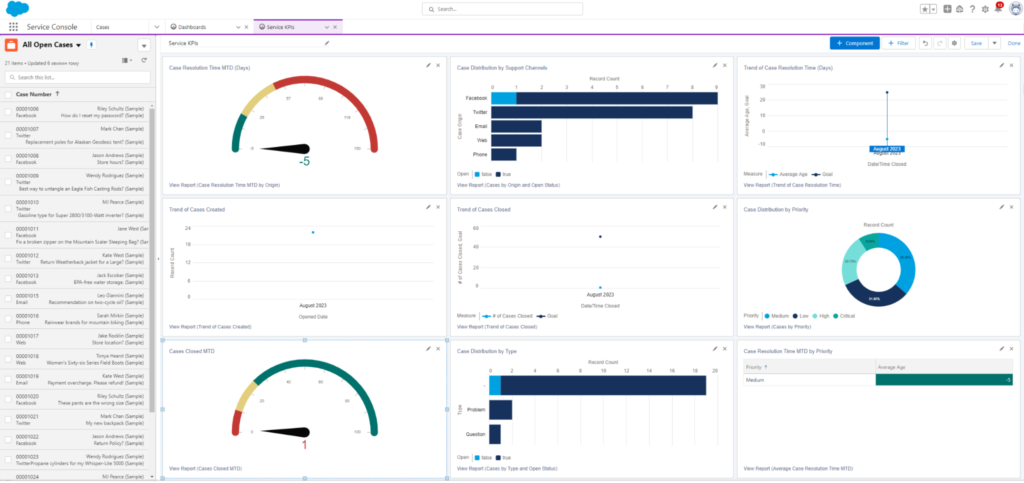
Dig Deeper With Tableau Dashboards
In a genuinely data-centric organization, every member is inspired and equipped to utilize data to address pressing questions. Utilizing a business intelligence tool like App Tableau enables team members to amalgamate data from diverse sources and craft detailed dashboards, unveiling customer insights that bolster and refine the decision-making process.
Your role determines the kind of customer data you delve into. To begin, craft a series of foundational dashboards suitable for every tier in the organization, from data analysts to top-tier executives. Below are descriptions of the three predominant types of customer dashboards, complemented with pertinent examples. Dive deeper by following the associated links.
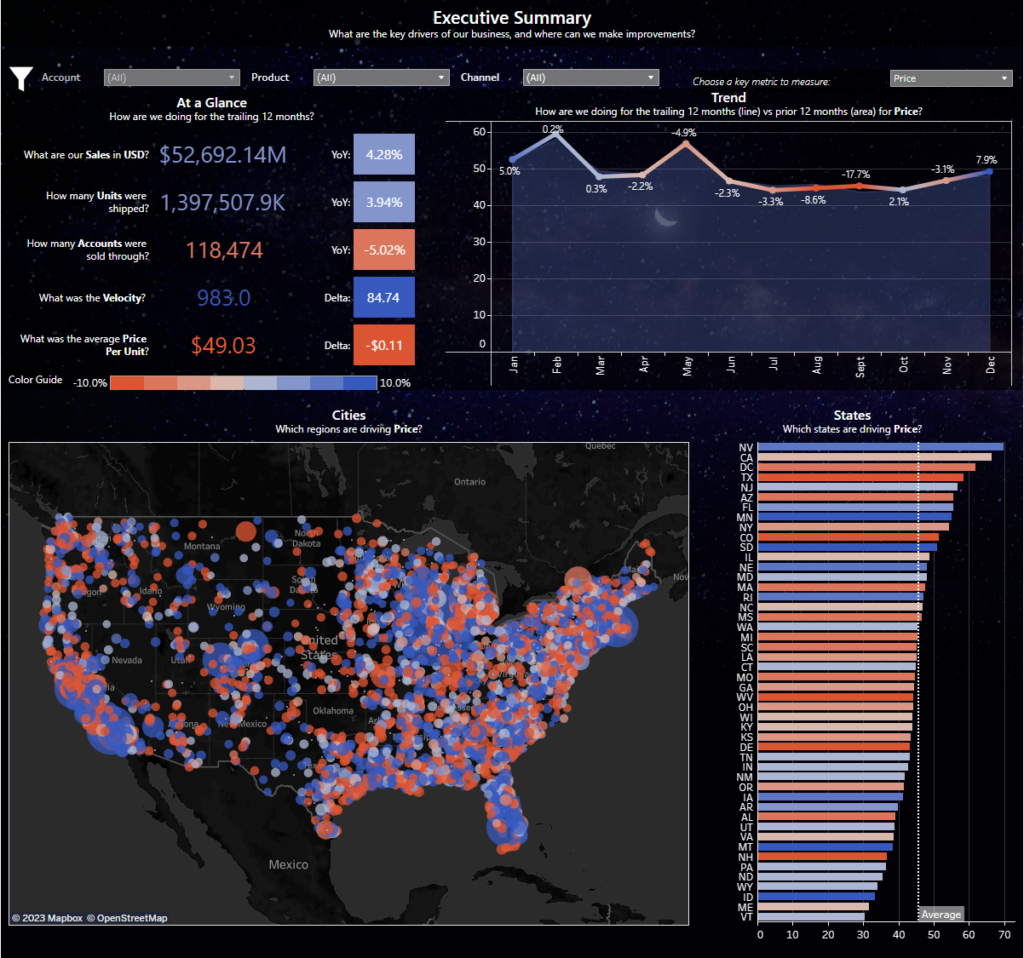
Salesforce CRM Dashboards
The Salesforce CRM dashboards consist of a set of preinstalled dashboards within the Analytics App. With these powerful dashboards, your sales and service teams can effectively manage deals and cases, leading to increased business closures within set timelines. Sales Managers can gain better visibility into open opportunities, enhancing pipeline predictability. These dashboards and reports serve as a starting point to simplify reporting in your organization.
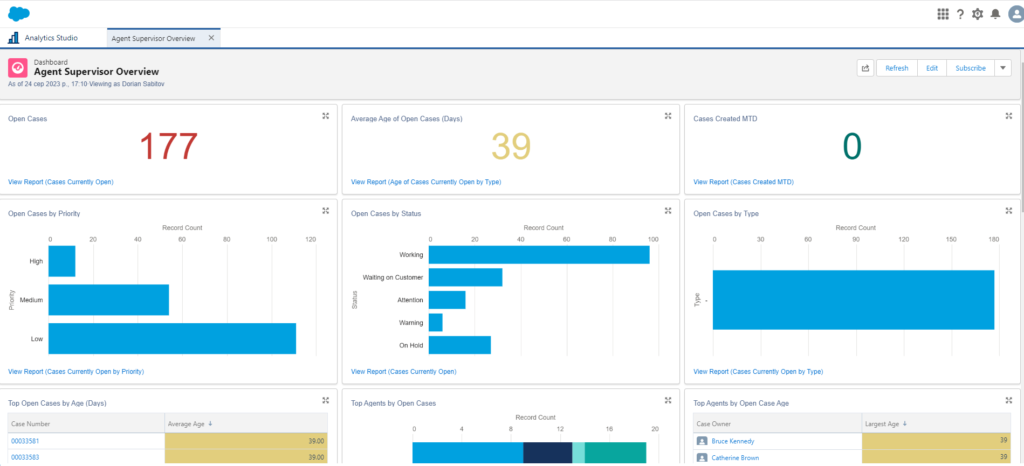
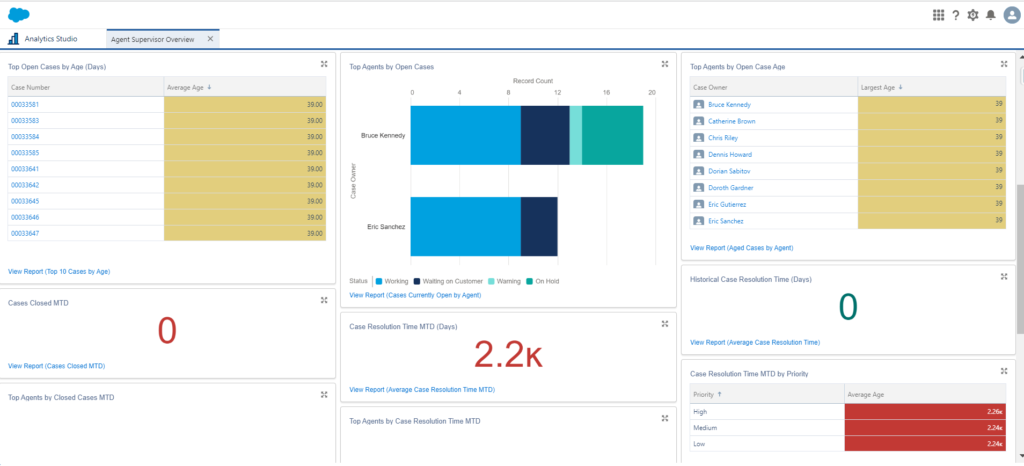
FAQs on Omnichannel KPIs Tracking in Salesforce
How does Salesforce Omni Channel Reporting enhance KPI tracking?
Salesforce Omni Channel Reporting provides a unified view of customer interactions across all channels, which is crucial for effective KPI tracking. This integration allows businesses to measure performance comprehensively, ensuring that every customer touchpoint is analyzed. The system’s robust analytics tools help in identifying trends, predicting customer behaviors, and optimizing channel performance, thus enhancing decision-making and strategic planning.
What are the key Salesforce Omnichannel benefits for businesses?
The primary benefits of Salesforce Omnichannel for businesses include improved customer experience, increased efficiency, and enhanced data consistency. By managing multiple channels within a single platform, businesses can provide a seamless customer experience, reducing response times and ensuring consistent service. Additionally, Salesforce Omnichannel enables better resource allocation, automating task distribution based on agent availability and skill set, which maximizes productivity and reduces overhead costs.
What are Omnichannel KPIs used to measure in marketing?
Omnichannel KPIs in marketing are used to measure a variety of factors including customer engagement, conversion rates, customer retention, and overall channel effectiveness. These KPIs help marketers understand how different channels contribute to customer journeys and where adjustments may be needed to optimize interactions. Commonly tracked metrics include click-through rates, bounce rates, cart abandonment rates, and customer lifetime value, which together provide a comprehensive picture of marketing effectiveness across channels.
How Omnichannel Retail KPIs in Salesforce are tracked?
In Salesforce, Omnichannel retail KPIs are tracked through integrated CRM tools that monitor sales, customer service interactions, and marketing campaigns across all retail channels. The platform allows for the customization of dashboards and reports to focus on specific KPIs such as sales volume, average order value, return on investment, and customer satisfaction scores. This data is accessible in real-time, enabling retail managers to make immediate adjustments to improve performance and enhance customer satisfaction across different retail touchpoints.
In Conclusion
Implementing and effectively tracking omnichannel KPIs is essential for businesses that aim to deliver a consistent and superior customer experience across different channels. By focusing on critical metrics, ranging from conversion rates and response times to customer satisfaction and return on investment, companies can obtain a comprehensive perspective of their performance. This broadened view not only identifies areas that require enhancement but also provides actionable insights. As we delve deeper into an era where customer preferences and behaviors are continuously evolving, harnessing these metrics becomes the cornerstone for maintaining relevance, ensuring growth, and driving sustained profitability.

Dorian is a 6X Certified Salesforce Developer and Administrator with a start in the IT world as a CRM Admin in 2020. Since diving into Salesforce in 2021 via Trailhead and Focus on Force, he has achieved a Ranger Rank, earned several Superbadges, and bagged certifications including the Salesforce Certified Platform Administrator, Platform App Builder, Platform Foundations and Platform Developer by 2023. In 2024 he also became Salesforce Certified AI Associate and earned Agentforce Specialist Certification in 2025. Dorian is very keen on continuous learning, always looks for fresh ways to improve his knowledge. He enjoys running, boxing, kickboxing and reading diverse kinds of books in his free time.

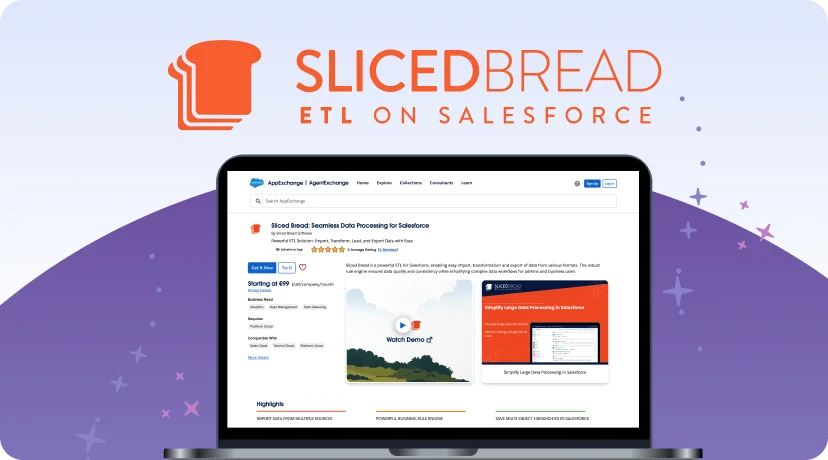
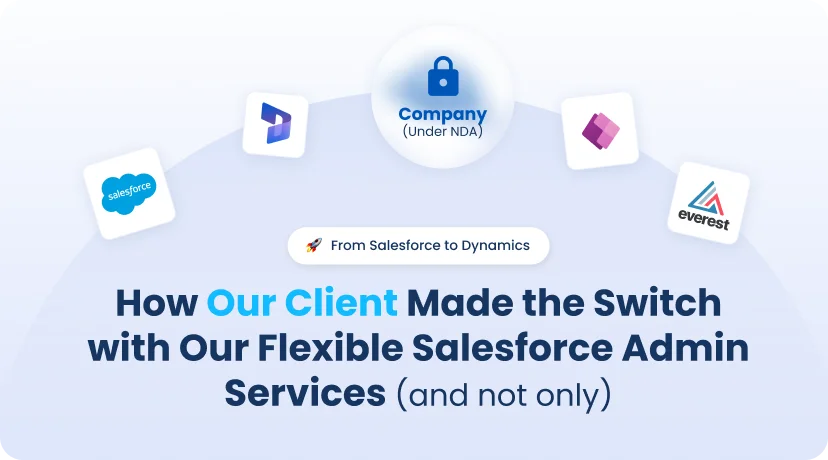


 Previous Post
Previous Post Next Post
Next Post
– Combine data from all channels into a unified system to get a complete view of the customer journey. Tools like Salesforce are great for this.
– Segment customers based on their behaviors and purchase history to tailor your marketing efforts more effectively.
– Implement personalized marketing strategies to boost customer engagement and retention.
– Regularly track important KPIs like Net Promoter Score (NPS), Average Order Value (AOV), and Customer Retention Rate.
Tools to use:
Salesforce – for integrating and analyzing customer data.
Tableau – for visualizing data and gaining insights.
Other Customer Data Platforms (CDPs) – other platforms that can help centralize and analyze data from multiple sources.
Hope it helps,
Dorian